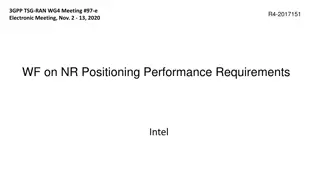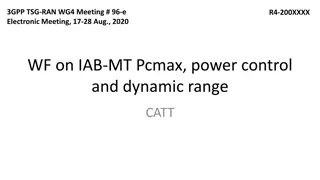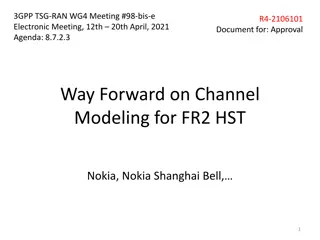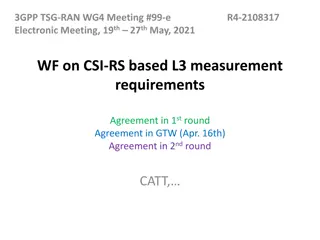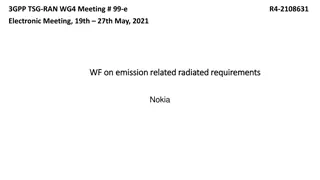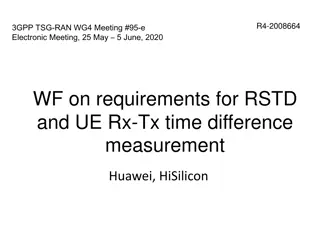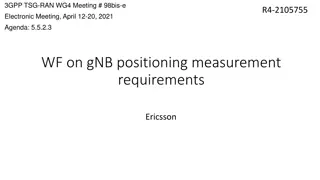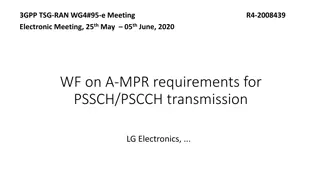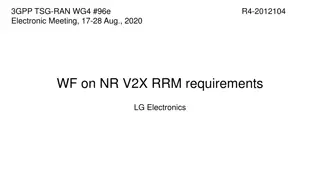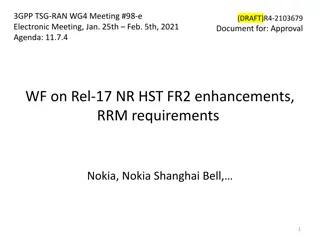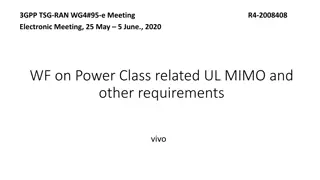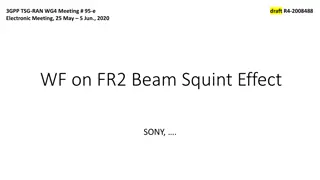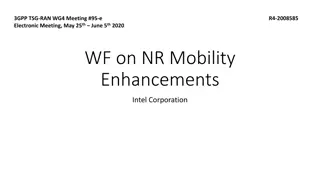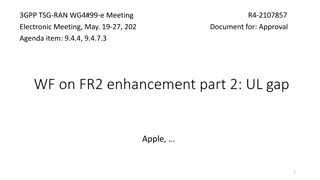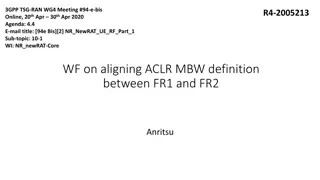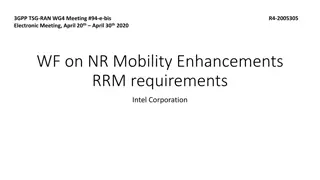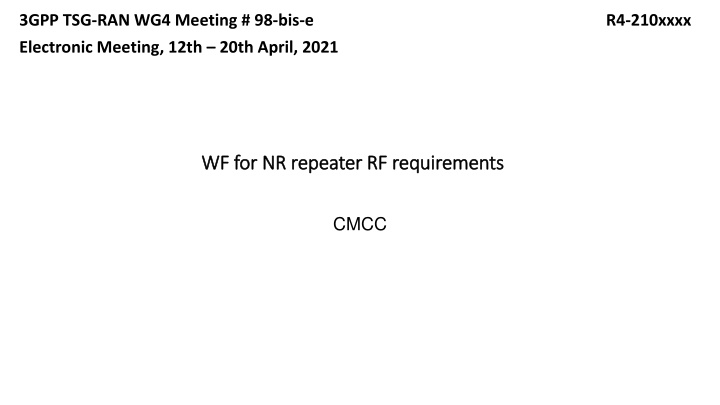
NR Repeater RF Requirements - 3GPP TSG-RAN Meeting Summary
The 3GPP TSG-RAN Working Group 4 recently approved a new work item for NR repeaters, focusing on specifying RF and EMC requirements for both FR1 and FR2 bands. This work aims to leverage RF specifications from LTE repeaters and IAB while considering various constraints and requirements for TDD repeaters. Further details include discussions on AGC/ALC requirements, output power definitions, and considerations for UL backhaul links. Stay updated with the latest developments in NR repeater technology.
Download Presentation

Please find below an Image/Link to download the presentation.
The content on the website is provided AS IS for your information and personal use only. It may not be sold, licensed, or shared on other websites without obtaining consent from the author. If you encounter any issues during the download, it is possible that the publisher has removed the file from their server.
You are allowed to download the files provided on this website for personal or commercial use, subject to the condition that they are used lawfully. All files are the property of their respective owners.
The content on the website is provided AS IS for your information and personal use only. It may not be sold, licensed, or shared on other websites without obtaining consent from the author.
E N D
Presentation Transcript
3GPP TSG-RAN WG4 Meeting # 98-bis-e R4-210xxxx Electronic Meeting, 12th 20th April, 2021 WF for NR repeater RF requirements WF for NR repeater RF requirements CMCC
Background on NR repeater RAN#90e approved a new New WID on NR Repeaters with RAN4 as the responsible WG. The objective of the WID is listed as below: Normative work phase objective [RAN4] Specify RF and EMC requirements for NR repeaters Consider FR1 (FDD and TDD) and FR2 (TDD) bands For the above objective, the leveraging of RF specifications for LTE repeater and IAB should be sought. It is assumed that the repeater does not perform adaptive beamforming towards the UE. It is assumed that the TDD repeater meets both BS and UE emission requirements (or the more stringent absolute level in dBm) in all slots. The following constraint may be considered for TDD repeaters, as needed, to contain the workload associated with this project: TX EIRP/TRP/power of Repeater not exceeding any UE power class defined in the band Note: FR1 FDD repeaters testing is assumed to be conducted. This assumption can be revisited in RAN#91.
WF on AGC/ALC related conducted requirements No dedicated ALC/AGC requirements are needed at least for the stationary repeater FFS on how to verify ALC/AGC actions. One candidate approach is to verify other key requirements e.g. power and emissions related requirements with several input power levels. Then the ALC/AGC would be implicitly tested. FFS about ACL/AGC requirements for moving repeater.
WF on FR1 DL(access link) output power related conducted requirements Wait for the conclusion of NR repeater classes before the definition of output power for DL(access link). Once it is agreed to define different classes, appropriate power upper limits could be applied to. Option 1: Specified upper limits for all repeaters Further check whether these upper limits are per carrier or per passband Option 2: Reuse the same approach and upper limits as BS, e.g. no upper limits for WA, 38dBm and 24dBm upper limits for MR and LA respectively Further check whether these upper limits are per carrier or per passband Option 3: Reuse the same approach as BS/IAB, however, further check the upper limits, especially for those classes that don t have such limits in BS/IAB spec Option 4: reuse the same approach as E-UTRA repeater, i.e. output power is based on declaration without any specified power upper limits
WF on FR1 UL(backhaul link) output power related conducted requirements FFS on UL output power, taking following aspects into consideration avoiding performance degradation of other network from the point of UL co-existence LTE FDD repeater which is already in operation and having more output power should not be excluded from 3GPP requirements when it is converted to NR Relationship to LTE FDD repeater UL power near-far effect, which means repeater could only use the same compressed gain to amplify signal from UE far away from repeater because repeater have to compress its gain to guarantee amplified signal from nearby UE is not larger than the maximum value and then the output power could be lower
WF on FR1 UL(backhaul link) output power related conducted requirements Candidate options for UL output power definition Option 1: Specified upper limits for all repeaters Option 2: not exceeding existing UE power class Option 3: exceeding existing UE power class Option 4: reusing the same approach as E-UTRA repeater for both TDD UL and FDD UL, i.e. output power is based on declaration without any power upper limits Option 5: reusing the same approach as E-UTRA repeater only for FDD UL, i.e. output power is based on declaration without any power upper limits specification Option 6: reusing the same approach as BS/IAB, however, further check the upper limits, especially for those classes that don t have such limits in BS/IAB spec
WF on FR1 power tolerance related conducted requirements Wait for the conclusion of class definitions and power limits FFS on whether reuse the same power tolerance requirements as E-UTRA repeater spec or not
WF on FR1 ACLR related conducted requirements FFS on ACLR or some equivalent requirements with adjacent NR channel to match the same adjacent channel protection as NR/IAB spec. FFS on whether existing BS OBUE and EVM requirements could sufficiently cover ACLR requirements or not? The equivalent requirements may include modified OBUE requirements and absolute ACLR. FFS on how to set either absolute ACLR or modified OBUE or both of these two requirements as equivalent requirements. These two requirements are similar absolute metrics with narrower adjacent channel instead of the whole channel BW. It is suggested to embark on technical analysis instead of simulation at first.
WF on FR1 ACLR related conducted requirements FFS on ACLR with adjacent E-UTRAchannel requirements. It is suggested to embark on technical analysis instead of simulation at first. FFS on absolute requirements based on achieving same emissions power as an assumed UE/BS meeting ACLR requirements with a reference power.
WF on FR1 spurious related conducted requirements The same spurious emission requirements as BS spec still apply to DL(access link). FFS on whether it could be reused for UL(backhaul link) , especially for FDD NR repeater spurious emission could include general spurious emission, co- location with other base stations, Co-existence with other systems in the same geographical area, Protection of BS receiver for FDD operating band, regional and regulation related requirements. Only Tx spurious emission is sufficient and Rx spurious emission is not necessary for FDD repeater. FFS on whether Rx spurious emission is necessary for TDD repeater.
WF on FR1 frequency deviation related requirements The frequency deviation of the output signal with respect to the input signal shall be no more than 0.01 ppm for FR1. - Further consider if it s absolute error or relative error.
WF on FR1 EVM related conducted requirements FFS on EVM whether to define EVM limits or based on manufacture s declaration. FFS on which modulation up to 256QAM is feasible FFS to differentiate different modulation schemes for DL and UL respectively FFS on only one EVM level or more than one levels. If multiple EVM levels are agreed, the modulation schemes are based on declaration or not? FFS on whether to define more stringent requirements than current spec or not
WF on FR1 input intermodulation related conducted requirements Take the same approach of E-UTRAN repeater as baseline including general requirements, co-existence and co-location requirements. FFS on whether some adjustment is necessary or not, e.g. frequency offset
WF on FR1 output intermodulation related conducted requirements Take BS Transmitter intermodulation requirement as the baseline for DL (access link) with 30dB coupling loss assumption when define interfering signal level. FFS on output intermodulation for UL (backhaul link)
WF on FR1 ACRR related conducted requirements Take E-UTRA repeater specification as the baseline when define ACRR requirement for NR repeater. FFS on whether consider the adjacent channel within the passband Further consider the large NR CBW. The effect of NR bandwidths wider than E-UTRA is FFS
WF on FR1 out of band gain related conducted requirements FFS on out of band gain requirements FFS on whether take E-UTRA repeater spec as the baseline. FFS on whether to update assumptions considering higher output power is assumed for NR repeater FFS on co-located out of band gain requirement. Which kind of co-located requirement is preferred? No requirements, optional requirements or mandatory requirements? FFS on the necessity of co-existence simulation. Whether only technical analysis is sufficient FFS on how to define coupling loss and power of another transmitter, some candidate options Options 1: only considering donor coupling loss as E-UTRA repeater spec Option 2: Base on assumed MCL to another transmitter with the same output power as a BS
WF on FR1 TDD OFF related conducted requirements FFS on TDD OFF requirements Further discussion on whether TDD OFF requirements are necessary Further discussion on how to define these requirements. One candidate option is verifying these requirements with synchronization or switching time requirements.
WF on FR1 REFSENSE or equivalent conducted requirements FFS on REFSENSE or equivalent conducted requirements FFS on whether these requirements are needed or not The candidate requirements include NF Minimum input value
WF on FR2 DL(access link) power related requirements At least define TRP requirements for FR2 repeater. FFS on EIRP requirements Output power for FR2 repeater is based on declaration without upper limit in DL(access link) TRP accuracy requirement for DL(access link) should be the same as BS spec FFS on conformance test.
WF on FR2 UL(backhaul link) power related requirements FFS on FR2 UL(backhaul link) output power in terms of TRP , taking following aspects into consideration based on declaration without upper limit or not
WF on FR2 ALC related requirements FFS on FR2 ALC requirements, taking following aspects into consideration whether to implicitly specify ALC requirements or not ALC may be only needed in context of limiting maximum output power, unwanted emissions and output signal quality with high-power input signal that leads to gain limits
WF on FR2 ACLR or some equivalent requirements FFS on relative ACLR or some equivalent requirements to match the same adjacent channel protection as NR/IAB spec. FFS on whether existing BS OBUE and EVM requirements could sufficiently cover ACLR requirements or not? The equivalent requirements may include modified OBUE requirements and absolute adjacent channel emissions power. FFS on how to set either absolute ACLR or modified OBUE or both of these two requirements as equivalent requirements. These two requirements are similar absolute metrics with narrower adjacent channel instead of the whole channel BW.
WF on FR2 Tx spurious requirements At least for DL, the same spurious emissions requirements as BS could be reused for NR repeater including category A/B and protection of ESS. FSS on whether these same requirements could still apply to UL? Rx spurious emission is not necessary for FR2 repeater.
WF on FR2 frequency deviation requirements The frequency deviation of the output signal with respect to the input signal shall be no more than [ 0,01] PPM for FR2. - Further consider if it s absolute error or relative error.
WF on FR2 out of band gain requirements FFS on out of band gain, taking following aspects into consideration deployment scenarios and expected repeater gain etc. FFS on whether only reasonable analysis is sufficient or extra simulation is also required.
WF on FR2 EVM requirements FFS on FR2 EVM definition, taking following aspects into consideration whether explicitly define EVM limits or based on repeater manufacture s declaration. which modulation up to 256QAM(DL) and 64QAM(UL) is feasible whether to differentiate different modulation scheme for DL and UL respectively only one EVM level or more than one level. If multiple EVM levels are agreed, the modulation schemes are based on repeater manufacture s declaration or not? whether to define more stringent requirements than current spec or not
WF on FR2 input IMD requirements FFS on input IMD Further check whether to define input IMD for FR2 Further check whether this requirement could be based on FR2 BS receiver intermodulation
WF on FR2 output IMD requirements FFS on output IMD Further check whether to define output IMD for FR2

